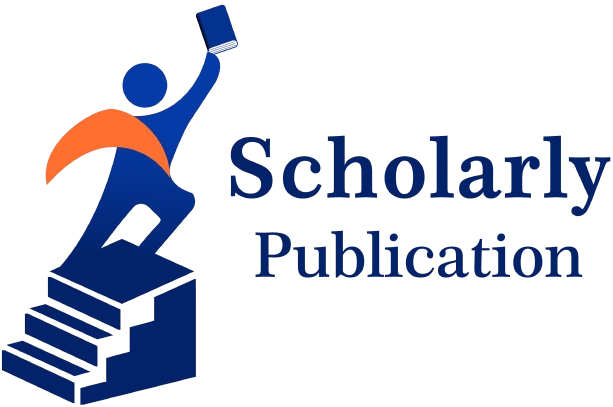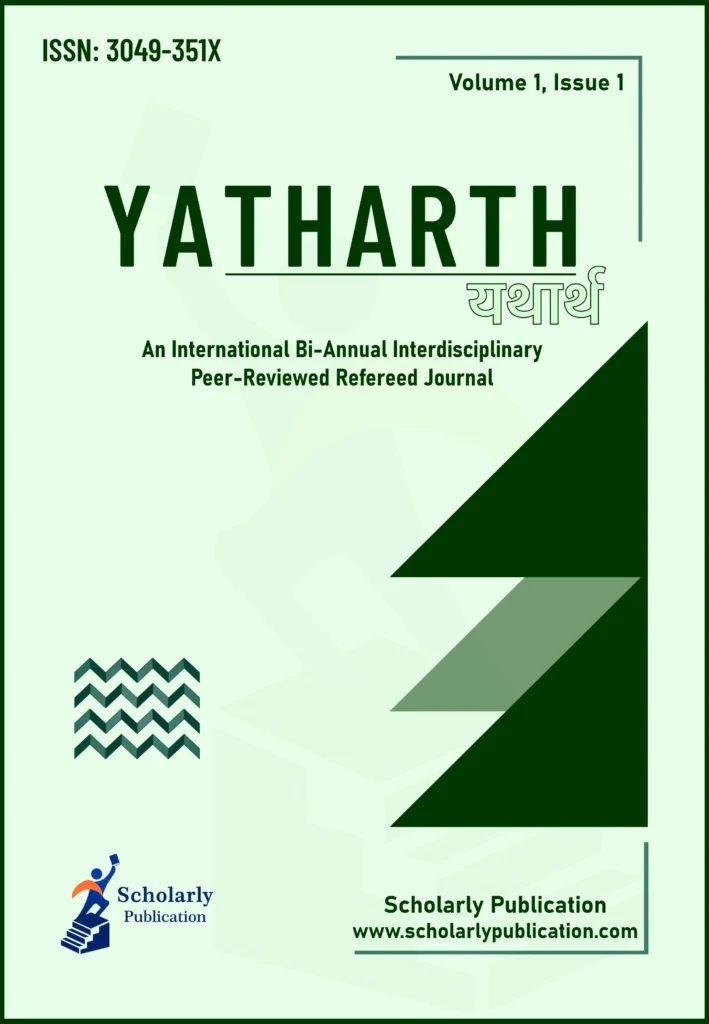Impact of Linguistic Diversity in Post Independent India
Volume 1, Issue 1, Article Number: 251009 (2025)
Home >> Yatharth >> Volume 1, Issue 1
aResearch Scholar, bAssistant Professor
Department of Political Science & School of Social Sciences; Mahatma Gandhi Central University, Gandhi Bhawan, Motihari, East Champaran – 845401, Bihar (India)
*Corresponding Author: ssspuja1012@gmail.com
Received: 05 April 2025 | Revised: 30 April 2025
Accepted: 06 May 2025 | Published Online: 14 May 2025
DOI: https://doi.org/10.5281/zenodo.15399592
© 2025 The Authors, under a Creative Commons license, Published by Scholarly Publication
Abstract
This paper investigates a detailed explication of the “Impact of Linguistic diversity in post-independent India” and its development process from independence to the present scenario. In post-independent India, the linguistic context has played a crucial role in shaping India’s social, political, and cultural fabric. Since India gained independence in 1947, linguistic diversity has influenced various aspects of Indian society. As a country with a diverse range of languages, India faces a unique set of challenges as well as opportunities. The research examines the linguistic policies implemented by the Indian government to promote linguistic harmony among diverse linguistic social groups. It also examines how language shapes regional identities, political affiliations, and cultural dimensions. A study examines the challenges posed by linguistic diversity in governance, education, and social integration, looking at both the positive and negative contributions and also potential tensions related to linguistic diversity. This research examines historical developments, policy changes, and social dynamics to gain a deeper understanding of how linguistic diversity shapes the contemporary Indian experience. A more inclusive and harmonious society in post-independent India can only be achieved by recognizing and managing linguistic diversity.
Keywords
Commission, Constitution, Democracy, Linguistic Diversity, Post independence Society, State Reorganization
References
- Chandramouli, C. (2011). Census of India. Office of the Registrar General and Census Commissioner, New Delhi, India.
- Mukherjee, T. (2014). Teaching of English as a Second Language in India. e-Pg Pathshala. (accessed on 2 February 2022)
- Shubhangi, R. (2014). Problem created by Language in Indian Politics. Political Science. (accessed on 6 August 2021)
- Constituent Assembly Debate (1946-1950). Government of India Press.
- The Constituent Assembly of India (Legislative) Debates – 1949, Volume IV. Government of India Press. (accessed on 25 May 2022)
- Secretariat, L. S. (2014). Constituent Assembly Debates Official Report Vol. 1. Jainco Art India. (accessed on 25 May 2022)
- Ministry of Home Affairs. (2017). Constitutional Provisions Relating to Eighth Schedule. Government of India Press.
- Rao, D. G. (2020). Promotion of Indian Languages: NEP 2020. Central Institute of Indian Language. (accessed on 28 April 2025)
- Deshpande, S. K. (2019). Hinglish Hamari Identity: The Language of Advertising in India. International Journal of English Language, Literature in Humanities, 7, 15-15.
- Language Census Data (2011).
- India, G. (1955). Report of the States Reorganisation Commission. Government of India Press, New Delhi. (accessed on 25 March 2022)
- Commission, S. R. (1955). Report of the States Reorganisation Commission. Government of India. (accessed on 12 June 2022)
- Weiner, M. (1968). State politics in India. Princeton University Press, 176.
- Malhotra, A., & Mir, F. (2012). Punjab Reconsidered: History, Culture, and Practice. Oxford University Press.
- Ananth, V. K. (2013). Regional Identities and its Implications on the Notion of National Identity: Some Observations on the Linguistic Reorganisation of States. Karatoya: NBU J. Hist., 6, 128-143.
- Lamba, K. G. (1999). Dynamics of Punjabi Suba Movement. Deep and Deep Publications.
- Brass, P. R. (2005). Language, religion and politics in North India. iUniverse.
- Krishnan, R. K., Sriramchandran, R. & Subagunarajan (2022). Rule of the Commoner: DMK and Formations of the Political in Tamil Nadu, 1949-1967. Cambridge University Press. ISBN. 978-1-009-19717-5
- Barnett, M. R. (2015). The politics of cultural nationalism in South India. Princeton University Press.
- Hardgrave Jr, R. L. (1965). The Dravidian Movement. Routledge. 91-96.
- Narang, K. S., & Gupta, H. R. (1969). History of the Punjab: 1500-1858. U. C. Kapoor & Sons, Delhi. (accessed on 21 June 2023)
- Parmar, Y.S (1968). Himachal Pradesh: Case for statehood. Directorate of Public Relations Publishers. 48-54.
- Baruah, S. (1999). India Against Itself: Assam and the Politics of Nationality. University of Pennsylvania Press.
- Syiemlieh, D. R., Bhattacharjee, J. B. (2013). Early States in North East India. Regency Publications. (accessed on 7 March 2022)
- Chaube, S. K. (2012). Hill Politics in North-East India. Orient Blackswan, ISBN. 9788125045502.
- Bhaumik, Subir. (1996). Insurgent Crossfire: North-East India. Lancer Publishers.
- Kamath, S. U. (1980). A Concise History of the Karnataka: From Prehistoric time to Present. Archana Prakashana, Bangalore.
- Kumar, D. (2016). Constitution of a Region: A Study of Chhattisgarh. In Rethinking State Politics in India. Routledge India, 76-106.
[View Chapter] [Google Scholar]
- Rawat, A. S. (2011). History of the formation of Uttarakhand. Manohar Publishers & Distributors, New Delhi. ISBN 978-8179882054
- Sharma, A. P. (1988). The Jharkhand movement: A critique. Social Change, 18, 59-82.
[View Article] [Google Scholar]
- Munda, R. D., & Bosu Mullick, S. (2003). The Jharkhand Movement. Indigenous Peoples’ Struggle for Autonomy in India. IWGIA document, 2003, 400.
- Reddy, G. R. & Sharma, B. A. V. (2014). Regionalism in India: A Study of Telangana. Concept Publishing Company, New Delhi.
- Hausing, K. K. S. (2018). Telangana and the politics of State formation in India: Recognition and accommodation in a multinational federation. Regional & Federal Studies, 28, 447-468.
[View Article] [Google Scholar]
- Reddy, A. A., & Bantilan, M. C. S. (2013). Regional disparities in Andhra Pradesh, India. Local Economy, 28, 123-135.
[View Article] [Google Scholar]
- Srikrishna, B. N., Duggal, V. K., Singh, R., Shariff, A., & Kaur, R. (2010). Committee for consultations on the situation in Andhra Pradesh. Ministry of Home Affairs, Government of India, Delhi.
- Tillin, L. (2013). Remapping India: New states and their political origins. Hurst Publishers.
- Bagchi, R. (2012). Gorkhaland: Crisis of Statehood. SAGE Publications Pvt. Ltd.
- Singh, K. S. (1997). The Scheduled Tribes. Oxford University Press in collaboration with the Anthropological Survey of India, New Delhi.
- People’s Representation Act of 1951.
Cite This Article
P. Kumari and P. Bhaduli, “Impact of Linguistic Diversity in Post Independent India,” Yatharth 1(1) (2025) 251009. https://doi.org/10.5281/zenodo.15399592
Rights & Permission
This is an open access article published under the Creative Commons Attribution (CC BY) International License, which allows unrestricted use, distribution, and reproduction in any medium, provided the original work is properly cited. No permission is needed to reuse this content under the terms of the license.
For uses not covered above, please contact the Scholarly Publication Rights Department.

